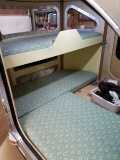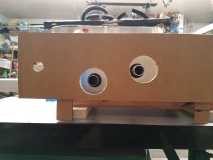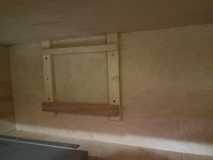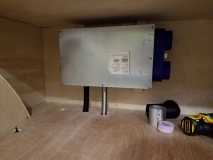Rough Road Raindrop
Re: Rough Road Raindrop
No pictures for today. I spent a good portion on my back under the trailer holding up a Propex 2211 to try and determine the mounting bracket I'll need to weld up and the routing for the hoses. I also got the third brake light wired up and functional. I'll try and get some pictures of it down the road. I picked up an 11lb propane bottle and bracket from Adventure Trailers, so I need to figure out how to mount that on the tongue and run the gas tubing back to the furnace. I'm also planning on having a tee in the gas line that will allow me to connect the stove and save on the 1lb bottles. My plate wasn't full enough, so I also started sewing covers for the bed cushions. We had been using them with regular mattress pad covers but this will make them look a little nicer.
I picked up a couple of goodies from Sailrite that have made a world of difference in sewing up the mattress covers. I was having trouble finding a good way of marking the outdoor fabric I had selected for covering. Pencil didn't stick well, the sewing pencils took a lot of effort to leave a line and needed constant sharpening. I tried various markers that would either bleed or were visible on the opposite side. I ran across some marking chalk while poking around Sailrite's website and now that I've had a chance to use it, I highly recommend it. It's awesome. https://www.sailrite.com/Marking-Chalk
The other issue I've run into is keeping my fabric edges lined up right. Yeah, I've done the pins and notches and whatever else, but it's always been a bit of work trying to hold it all together til I can run it through the sewing machine. While poking around Sailrite's how-to videos on youtube I saw them using what they call basting tape. I ordered up a couple of rolls and it has greatly improved my sewing. I've still got a long way to go, but at least now things stay where I want them while sewing, and you don't have to worry about missing a pin. https://www.sailrite.com/Seamstick-1-4- ... vas-50-Yds
I picked up a couple of goodies from Sailrite that have made a world of difference in sewing up the mattress covers. I was having trouble finding a good way of marking the outdoor fabric I had selected for covering. Pencil didn't stick well, the sewing pencils took a lot of effort to leave a line and needed constant sharpening. I tried various markers that would either bleed or were visible on the opposite side. I ran across some marking chalk while poking around Sailrite's website and now that I've had a chance to use it, I highly recommend it. It's awesome. https://www.sailrite.com/Marking-Chalk
The other issue I've run into is keeping my fabric edges lined up right. Yeah, I've done the pins and notches and whatever else, but it's always been a bit of work trying to hold it all together til I can run it through the sewing machine. While poking around Sailrite's how-to videos on youtube I saw them using what they call basting tape. I ordered up a couple of rolls and it has greatly improved my sewing. I've still got a long way to go, but at least now things stay where I want them while sewing, and you don't have to worry about missing a pin. https://www.sailrite.com/Seamstick-1-4- ... vas-50-Yds
- Louisd75
- Teardrop Master
- Posts: 106
- Images: 209
- Joined: Wed Jul 17, 2013 4:27 am
- Location: Bellingham WA
Re: Rough Road Raindrop
I've been slowly chipping away at things. I'm done with four of the six cushion covers. I'll be happy when they're done, I'm not the greatest sewer. Here's how they're looking so far:

I think I took that pic when I only had three done. I've gotta finish the two cushions that go near the feet for the queen size bed. I figured I should probably get the furnace installed before I make those cushions, just in case something changes with my plan, even though that never happens
Anyhow, I've been toying around with where to mount the HS2211. It's sealed, so it can go under the trailer, the only downside becomes routing the four sections of ducting (hot/cold air and intake/exhaust). It also winds up at the back end of the trailer, which is a spot that Propex recommends avoiding. So, after a distinct lack of consulting with my significant other, I decided that since she's short that she can stand to lose some foot room and I would mount the furnace vertically at the foot of her side of the bed. I don't think she'll complain once it kicks on and makes things toasty warm. I hope. The pluses of an inside mount are pretty good as well. I only need to do two 2" and one 1/2" penetration instead of two 2" and two 3". It also avoids having to kink things up to get the ducting to where I want it, and I don't have to worry about sealing the ducts as well. I do need to worry about making sure that the exhaust tubing is well sealed, but that's only one tube. The furnace is also out of the elements and wheel spray and safe from accidental dunkings.
First up, I had to make a template. The HS2200 that I had previously came with a nice template. This one, not so much. So, I grabbed a piece of scrap cardboard and cut it out to give me an idea of where I would need to drill holes.

The holes really do line up, the picture just makes it look like they don't.
Next up, how the heck am I going to mount the dang thing. Propex recommends a minimum of 1" of clearance all the way around. Ok, no biggie. I built up a wooden frame which was then screwed and glued to the bulkhead at the foot of my wife's side of the trailer, like so:

The top rung has a fancy name which is escaping me at the moment. It's not cut square on the top surface. I ripped the board with the table saw set at an angle. One half of the board became the top rung, the other half is mounted to the furnace so that I can hang the furnace while securing it, thus freeing up my hands. It's really going to bug me now that I can't remember what it's called. This is what it looks like hanging:

Once I get everything else sorted I'll screw the furnace down tight, for now it's just hanging.
Oh, and I forgot about drilling the holes. I taped some cardboard scrap to the template I made and then set it on the floor in the general vicinity of where I wanted. The cardboard scraps extend off of the template the same distance as my fancy wooden mounting frame. I traced the openings and drilled an exploratory hole before crawling under and making sure I wasn't going to hit anything. Everything looked good, so out came the 2" hole saw and I went to town.
So far, I've got the intake/exhaust tubes temporarily installed. I need to pick up some fittings and tubing for the propane side of things to get that run. We're supposed to have another batch of snow roll in before the weekend, so if I hurry I might be able to get it so that I can try it out in the driveway this weekend. Or not. There's still a bit of work to be done to get this whole thing up and running. Once the furnace is mounted I plan on building an enclosure around it to box it in. I'll likely also vent that box to the outside, just in case anything starts leaking. I'd rather have it leak outside than into the trailer. Time to go crawl under the trailer for a bit, yeeha!
I think I took that pic when I only had three done. I've gotta finish the two cushions that go near the feet for the queen size bed. I figured I should probably get the furnace installed before I make those cushions, just in case something changes with my plan, even though that never happens

Anyhow, I've been toying around with where to mount the HS2211. It's sealed, so it can go under the trailer, the only downside becomes routing the four sections of ducting (hot/cold air and intake/exhaust). It also winds up at the back end of the trailer, which is a spot that Propex recommends avoiding. So, after a distinct lack of consulting with my significant other, I decided that since she's short that she can stand to lose some foot room and I would mount the furnace vertically at the foot of her side of the bed. I don't think she'll complain once it kicks on and makes things toasty warm. I hope. The pluses of an inside mount are pretty good as well. I only need to do two 2" and one 1/2" penetration instead of two 2" and two 3". It also avoids having to kink things up to get the ducting to where I want it, and I don't have to worry about sealing the ducts as well. I do need to worry about making sure that the exhaust tubing is well sealed, but that's only one tube. The furnace is also out of the elements and wheel spray and safe from accidental dunkings.
First up, I had to make a template. The HS2200 that I had previously came with a nice template. This one, not so much. So, I grabbed a piece of scrap cardboard and cut it out to give me an idea of where I would need to drill holes.
The holes really do line up, the picture just makes it look like they don't.
Next up, how the heck am I going to mount the dang thing. Propex recommends a minimum of 1" of clearance all the way around. Ok, no biggie. I built up a wooden frame which was then screwed and glued to the bulkhead at the foot of my wife's side of the trailer, like so:
The top rung has a fancy name which is escaping me at the moment. It's not cut square on the top surface. I ripped the board with the table saw set at an angle. One half of the board became the top rung, the other half is mounted to the furnace so that I can hang the furnace while securing it, thus freeing up my hands. It's really going to bug me now that I can't remember what it's called. This is what it looks like hanging:
Once I get everything else sorted I'll screw the furnace down tight, for now it's just hanging.
Oh, and I forgot about drilling the holes. I taped some cardboard scrap to the template I made and then set it on the floor in the general vicinity of where I wanted. The cardboard scraps extend off of the template the same distance as my fancy wooden mounting frame. I traced the openings and drilled an exploratory hole before crawling under and making sure I wasn't going to hit anything. Everything looked good, so out came the 2" hole saw and I went to town.
So far, I've got the intake/exhaust tubes temporarily installed. I need to pick up some fittings and tubing for the propane side of things to get that run. We're supposed to have another batch of snow roll in before the weekend, so if I hurry I might be able to get it so that I can try it out in the driveway this weekend. Or not. There's still a bit of work to be done to get this whole thing up and running. Once the furnace is mounted I plan on building an enclosure around it to box it in. I'll likely also vent that box to the outside, just in case anything starts leaking. I'd rather have it leak outside than into the trailer. Time to go crawl under the trailer for a bit, yeeha!
- Louisd75
- Teardrop Master
- Posts: 106
- Images: 209
- Joined: Wed Jul 17, 2013 4:27 am
- Location: Bellingham WA
 There's a ripped up package on the back door.
There's a ripped up package on the back door. 




 I need to get back to painting.
I need to get back to painting. 



